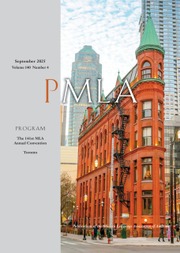No CrossRef data available.
Article contents
Theory Camp versus Commie Camp
Published online by Cambridge University Press: 28 October 2025
Abstract
An abstract is not available for this content so a preview has been provided. Please use the Get access link above for information on how to access this content.

Information
- Type
- Theories and Methodologies
- Information
- Copyright
- © 2025 The Author(s). Published by Cambridge University Press on behalf of Modern Language Association of America
References
Works Cited
Award record for the Institute on Marxism and the Interpretation of Culture [FAIN: EH-20314-83]. 1983. National Endowment for the Humanities, apps.neh.gov/publicquery/AwardDetail.aspx?gn=EH-20314-83.Google Scholar
Colbert, Soyica Diggs. Radical Vision: A Biography of Lorraine Hansberry. Yale UP, 2021.Google Scholar
Edwards, Brent Hayes. “An Invitation to the Archives.” Editor’s column. PMLA, vol. 138, no. 1, Jan. 2023, pp. 9–19.Google Scholar
Ehrenreich, Barbara, and Ehrenreich, John. “The New Left and the Professional-Managerial Class.” Radical America, vol. 11, no. 3, June 1977, pp. 7–24.Google Scholar
Foner, Henry. “From the Bandstand: The Odyssey of a Catskills Resort Musician.” Jewish Currents, 27 July 2015, jewishcurrents.org/from-the-bandstand-the-odyssey-of-a-catskills-resort-musician.Google Scholar
Hall, Stuart. “Cultural Studies and Its Theoretical Legacies.” 1992. Essential Essays, vol. 1, edited by Morley, David, Duke UP, 2018, pp. 71–99.10.1215/9781478002413-006CrossRefGoogle Scholar
Jameson, Fredric. “Notes toward a Marxist Cultural Politics.” Minnesota Review, vol. 5, no. 1, 1975, pp. 35–39.Google Scholar
Krieger, Murray. “The School of Criticism and Theory: An Allegorical History.” New Literary History, vol. 25, no. 4, 1994, pp. 881–93.CrossRefGoogle Scholar
Latimer, Dan. “Jameson and Post-modernism.” New Left Review, 1st series, no. 148, Dec. 1984, pp. 116–28.CrossRefGoogle Scholar
Mishler, Paul C. Raising Reds: The Young Pioneers, Radical Summer Camps, and Communist Political Culture in the United States. Columbia UP, 1999.Google Scholar
Mitchell, Nick. “(Critical Ethnic Studies) Intellectual.” Critical Ethnic Studies, vol. 1, no. 1, 2015, pp. 86–94.10.5749/jcritethnstud.1.1.0086CrossRefGoogle Scholar
“The Mother Language Association.” 1969. New University Conference Records, 1968–72, Wisconsin Historical Society, Madison, box 13, folder 5.Google Scholar
Nelson, Cary. “Marxism and the Interpretation of Culture at 25: Theories for the New Millennium: Cary Nelson’s Opening Remarks.” Kritik, 18 Feb. 2013, unitcrit.blogspot.com/2013/02/marxism-and-interpretation-of-culture_18.html.Google Scholar
Ohmann, Richard M. English in America: A Radical View of the Profession. Wesleyan UP, 1996.Google Scholar
Perry, Imani. Looking for Lorraine: The Radiant and Radical Life of Lorraine Hansberry. Beacon Press, 2018.Google Scholar
Ransom, John Crowe. “The Communities of Letters.” Poems and Essays, Vintage, 1955, pp. 109–17.Google Scholar
The Rockefeller Foundation Annual Report, 1947. Rockefeller Foundation, 1948.Google Scholar
Schrecker, Ellen. The Lost Promise: American Universities in the 1960s. U of Chicago P, 2021.10.7208/chicago/9780226200996.001.0001CrossRefGoogle Scholar
Schryer, Stephen. Fantasies of the New Class: Ideologies of Professionalism in Post–World War II American Fiction. Columbia UP, 2011.Google Scholar
Stallknecht, Newton. “The School of Letters of Indiana University: A Study in Retrospect.” Yearbook of Comparative and General Literature, vol. 24, 1975, pp. 24–35.Google Scholar
Story, Patrick. “The Spirit of St. Cloud: A Report.” Minnesota Review, vol. 10, no. 1, 1978, pp. 131–33.Google Scholar
Yelin, Louise, et al. “A Letter to Richard Ohmann and His Reply.” The Radical Teacher, no. 3, 1976, pp. 16–17.Google Scholar

